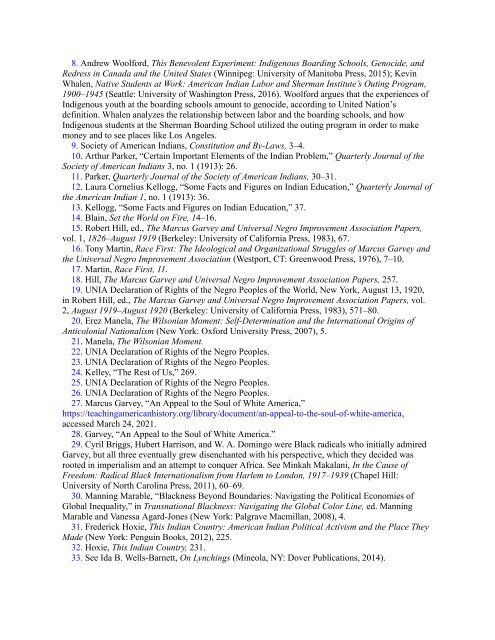Create successful ePaper yourself
Turn your PDF publications into a flip-book with our unique Google optimized e-Paper software.
8. <strong>An</strong>drew Woolford, This Benevolent Experiment: <strong>Indigenous</strong> Boarding Schools, Genocide, and<br />
Redress in Canada and <strong>the</strong> <strong>United</strong> <strong>States</strong> (Winnipeg: University <strong>of</strong> Manitoba Press, 2015); Kevin<br />
Whalen, Native Students at Work: American Indian Labor and Sherman Institute’s Outing Program,<br />
1900–1945 (Seattle: University <strong>of</strong> Washington Press, 2016). Woolford argues that <strong>the</strong> experiences <strong>of</strong><br />
<strong>Indigenous</strong> youth at <strong>the</strong> boarding schools amount to genocide, according to <strong>United</strong> Nation’s<br />
definition. Whalen analyzes <strong>the</strong> relationship between labor and <strong>the</strong> boarding schools, and how<br />
<strong>Indigenous</strong> students at <strong>the</strong> Sherman Boarding School utilized <strong>the</strong> outing program in order to make<br />
money and to see places like Los <strong>An</strong>geles.<br />
9. Society <strong>of</strong> American Indians, Constitution and By-Laws, 3–4.<br />
10. Arthur Parker, “Certain Important Elements <strong>of</strong> <strong>the</strong> Indian Problem,” Quarterly Journal <strong>of</strong> <strong>the</strong><br />
Society <strong>of</strong> American Indians 3, no. 1 (1913): 26.<br />
11. Parker, Quarterly Journal <strong>of</strong> <strong>the</strong> Society <strong>of</strong> American Indians, 30–31.<br />
12. Laura Cornelius Kellogg, “Some Facts and Figures on Indian Education,” Quarterly Journal <strong>of</strong><br />
<strong>the</strong> American Indian 1, no. 1 (1913): 36.<br />
13. Kellogg, “Some Facts and Figures on Indian Education,” 37.<br />
14. Blain, Set <strong>the</strong> World on Fire, 14–16.<br />
15. Robert Hill, ed., The Marcus Garvey and Universal Negro Improvement Association Papers,<br />
vol. 1, 1826–August 1919 (Berkeley: University <strong>of</strong> California Press, 1983), 67.<br />
16. Tony Martin, Race First: The Ideological and Organizational Struggles <strong>of</strong> Marcus Garvey and<br />
<strong>the</strong> Universal Negro Improvement Association (Westport, CT: Greenwood Press, 1976), 7–10.<br />
17. Martin, Race First, 11.<br />
18. Hill, The Marcus Garvey and Universal Negro Improvement Association Papers, 257.<br />
19. UNIA Declaration <strong>of</strong> Rights <strong>of</strong> <strong>the</strong> Negro Peoples <strong>of</strong> <strong>the</strong> World, New York, August 13, 1920,<br />
in Robert Hill, ed., The Marcus Garvey and Universal Negro Improvement Association Papers, vol.<br />
2, August 1919–August 1920 (Berkeley: University <strong>of</strong> California Press, 1983), 571–80.<br />
20. Erez Manela, The Wilsonian Moment: Self-Determination and <strong>the</strong> International Origins <strong>of</strong><br />
<strong>An</strong>ticolonial Nationalism (New York: Oxford University Press, 2007), 5.<br />
21. Manela, The Wilsonian Moment.<br />
22. UNIA Declaration <strong>of</strong> Rights <strong>of</strong> <strong>the</strong> Negro Peoples.<br />
23. UNIA Declaration <strong>of</strong> Rights <strong>of</strong> <strong>the</strong> Negro Peoples.<br />
24. Kelley, “The Rest <strong>of</strong> Us,” 269.<br />
25. UNIA Declaration <strong>of</strong> Rights <strong>of</strong> <strong>the</strong> Negro Peoples.<br />
26. UNIA Declaration <strong>of</strong> Rights <strong>of</strong> <strong>the</strong> Negro Peoples.<br />
27. Marcus Garvey, “<strong>An</strong> Appeal to <strong>the</strong> Soul <strong>of</strong> White America,”<br />
https://teachingamericanhistory.org/library/document/an-appeal-to-<strong>the</strong>-soul-<strong>of</strong>-white-america,<br />
accessed March 24, 2021.<br />
28. Garvey, “<strong>An</strong> Appeal to <strong>the</strong> Soul <strong>of</strong> White America.”<br />
29. Cyril Briggs, Hubert Harrison, and W. A. Domingo were Black radicals who initially admired<br />
Garvey, but all three eventually grew disenchanted with his perspective, which <strong>the</strong>y decided was<br />
rooted in imperialism and an attempt to conquer Africa. See Minkah Makalani, In <strong>the</strong> Cause <strong>of</strong><br />
Freedom: Radical Black Internationalism from Harlem to London, 1917–1939 (Chapel Hill:<br />
University <strong>of</strong> North Carolina Press, 2011), 60–69.<br />
30. Manning Marable, “Blackness Beyond Boundaries: Navigating <strong>the</strong> Political Economies <strong>of</strong><br />
Global Inequality,” in Transnational Blackness: Navigating <strong>the</strong> Global Color Line, ed. Manning<br />
Marable and Vanessa Agard-Jones (New York: Palgrave Macmillan, 2008), 4.<br />
31. Frederick Hoxie, This Indian Country: American Indian Political Activism and <strong>the</strong> Place They<br />
Made (New York: Penguin Books, 2012), 225.<br />
32. Hoxie, This Indian Country, 231.<br />
33. See Ida B. Wells-Barnett, On Lynchings (Mineola, NY: Dover Publications, 2014).


















